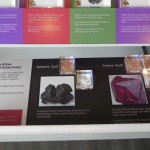 A 2014 Grant supported the Britannia Mine Museum Mineralogy Program Enhancement. This display complements the ‘What is an Element?’ display in our Minerals Unearthed classroom, funded by the CGF in 2012. There are three sections within the surface display, each having students compare descriptions of two minerals and then identify the elements that they are composed of, using clues from the mineral descriptions. The minerals for comparison are:
A 2014 Grant supported the Britannia Mine Museum Mineralogy Program Enhancement. This display complements the ‘What is an Element?’ display in our Minerals Unearthed classroom, funded by the CGF in 2012. There are three sections within the surface display, each having students compare descriptions of two minerals and then identify the elements that they are composed of, using clues from the mineral descriptions. The minerals for comparison are:
• Halite and sylvite – with potassium, chlorine, silicon, sodium
• Ruby and spinel – with magnesium, aluminum, chromium, oxygen
• Galena and cinnabar – with copper, sulphur, lead, mercury
 The elements are safely encased in acrylic resin and the blocks are free from the display meaning that students can lift them to examine closely. Beneath the surface display are three drawers. Each allows the students to take a closer look at the ratios of elements in minerals and how changing ratios changes the mineral. Those looked at are:
The elements are safely encased in acrylic resin and the blocks are free from the display meaning that students can lift them to examine closely. Beneath the surface display are three drawers. Each allows the students to take a closer look at the ratios of elements in minerals and how changing ratios changes the mineral. Those looked at are:
• Tenorite and cuprite
• Malachite and azurite
• Covellite and chalcocite
Like the surface display, the drawers comparing tenorite/curpite and covellite/chacocite contain the appropriate elements encased in resin. For these, the elements are in the correct ratios, e.g. tenorite has one oxygen and one copper block, whereas cuprite has one oxygen and two copper blocks. For the malachite and azurite drawer a specimen of each of the minerals was included to add variety to the display.
This display will be incorporated into the museum’s earth science school programs:




